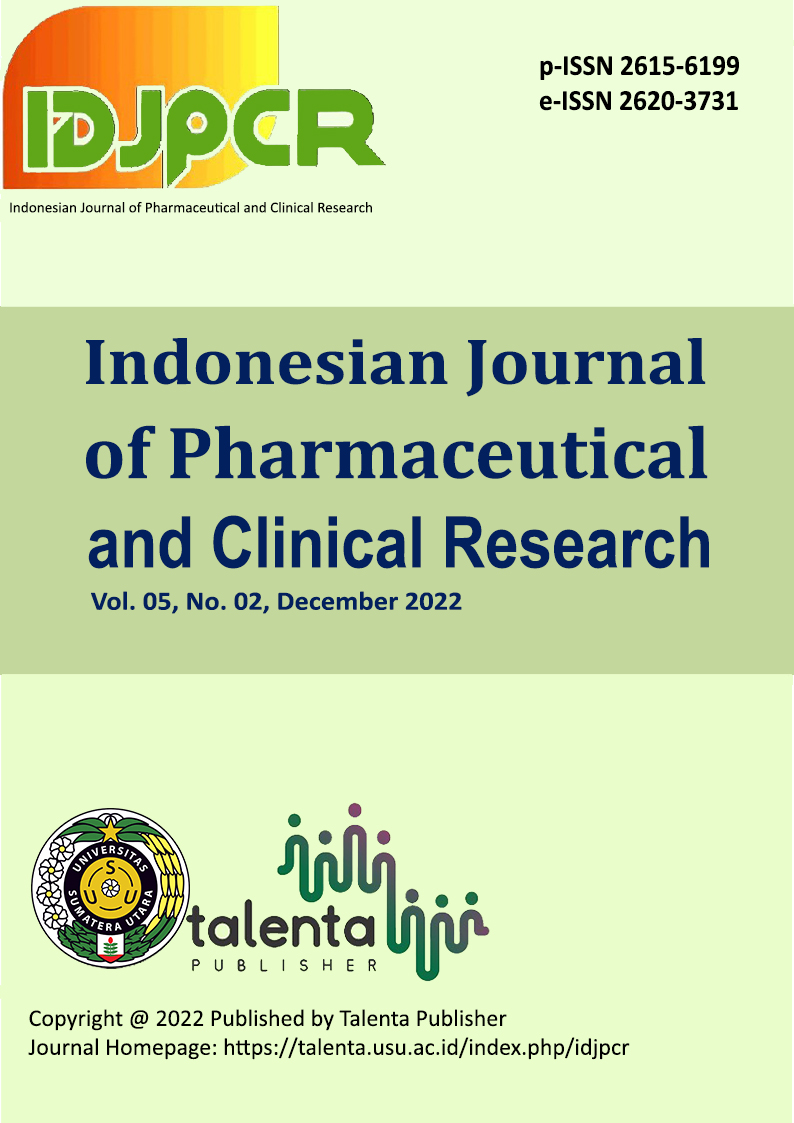Formulation and Evaluation of Body Scrub Cream Containing Ethanol Extract of Black Cumin Seeds (Nigella sativa L.) and Coffee Grounds (Coffea arabica L.) as Anti-aging
DOI:
https://doi.org/10.32734/idjpcr.v5i2.8256Keywords:
EENS (ethanolic extract N. sativa), Coffee Grounds, Body Scrub Cream, Antiaging.Abstract
Cosmetics are now mandatory for most women. Various natural ingredients have now been used as basic ingredients for beauty treatments. This study aimed to formulate and determine the effectiveness of body scrub cream preparations containing ethanolic extract of N. sativa and coffee grounds as antiaging. The skin antiaging was divided into five formulas: F0 (cream base), F1 (coffee ground 5%), F2 [coffee ground 5% + Ethanol Extract of N. sativa (EENS) 2%], F3 (coffee ground 5% + EENS 3.5%) and F4 (coffee ground 5% + EENS 5%). The body scrub cream preparations were subjected to organoleptic, homogeneity, emulsion type, and pH evaluation. The irritation test and antiaging activity were evaluated by using a skin analyzer. The body scrub was stable in 12-week storage. The result showed that there was no irritation on the volunteers’ skin. The body scrub cream with the highest antiaging activity was the F4 formula. It showed 9.6% for increasing skin moisture, 17.68% for increasing skin smoothness, 11.42% in reducing the size of pores and 12.84% in reducing the number of spots.
Downloads
References
B. Yu et al., “An elastic second skin,†Nat. Mater., vol. 15, no. 8, pp. 911–918, 2016, doi: 10.1038/nmat4635.
H. Yousef and S. Sharma, “Anatomy , Skin ( Integument ), Epidermis,†no. December, StatPearls [Internet], 2017.
M. Randhawa, T. Meyer, M. Sachdev, and R. K. Chaudhuri, “Standardized terminalia chebula fruit extract: A natural ingredient that provides long-lasting antioxidant protection and reverses visible signs of pollution-induced skin damage,†Clin. Cosmet. Investig. Dermatol., vol. 14, pp. 1257–1269, 2021, doi: 10.2147/CCID.S326492.
Hendrawati, A. K. Savitri, N. Fitriyati, and A. A. Mustika, “Formulation of the body scrub cream containing Moringa seed powder (Moringa oleifera) and its examination dermal acute irritation,†Int. J. GEOMATE, vol. 17, no. 62, pp. 244–249, 2019, doi: 10.21660/2019.62.4638.
A. Ervina, J. Santoso, B. F. Prasetyo, I. Setyaningsih, and K. Tarman, “Formulation and characterization of body scrub using marine alga Halimeda macroloba, chitosan and konjac flour,†IOP Conf. Ser. Earth Environ. Sci., vol. 414, no. 1, 2020, doi: 10.1088/1755-1315/414/1/012004.
R. Ganceviciene, A. I. Liakou, A. Theodoridis, E. Makrantonaki, and C. C. Zouboulis, “Skin anti-aging strategies,†Dermatoendocrinol., vol. 4, no. 3, 2012, doi: 10.4161/derm.22804.
D. Setyaningsih, P. L. Wijayanti, and N. Muna, “Application of mono-diacyl glycerol from palm oil by product as emulsifier for body scrub,†IOP Conf. Ser. Earth Environ. Sci., vol. 209, no. 1, pp. 1–11, 2018, doi: 10.1088/1755-1315/209/1/012047.
M. A. Nilforoushzadeh et al., “Skin care and rejuvenation by cosmeceutical facial mask,†J. Cosmet. Dermatol., vol. 17, no. 5, pp. 693–702, 2018, doi: 10.1111/jocd.12730.
J. Bravo et al., “Evaluation of spent coffee obtained from the most common coffeemakers as a source of hydrophilic bioactive compounds,†J. Agric. Food Chem., vol. 60, no. 51, pp. 12565–12573, 2012, doi: 10.1021/jf3040594.
M. A. Addicott et al., “The effect of daily caffeine use on cerebral blood flow: How much caffeine can we tolerate?,†Hum. Brain Mapp., vol. 30, no. 10, pp. 3102–3114, 2009, doi: 10.1002/hbm.20732.
M. S. Bin Sayeed et al., “Nigella sativa L. seeds modulate mood, anxiety and cognition in healthy adolescent males,†J. Ethnopharmacol., vol. 152, no. 1, pp. 156–162, 2014, doi: 10.1016/j.jep.2013.12.050.
S. M. Ali and G. Yosipovitch, “Skin pH: From basic science to basic skin care,†Acta Derm. Venereol., vol. 93, no. 3, pp. 261–267, 2013, doi: 10.2340/00015555-1531.
H. C. Ansel, Pengantar Bentuk Sediaan Farmasi. Jakarta: UI Press, 2005.
R. Voight, Buku Pelajaran Teknologi Farmasi, V. Gadjah Mada University Press, 1994.
Downloads
Published
How to Cite
Issue
Section
License
Copyright (c) 2022 Indonesian Journal of Pharmaceutical and Clinical Research

This work is licensed under a Creative Commons Attribution-ShareAlike 4.0 International License.
The Authors submitting a manuscript do so on the understanding that if accepted for publication, copyright of the article shall be assigned to Indonesian Journal of Pharmaceutical and Clinical Research (IDJPCR) and Faculty of Pharmacy as well as TALENTA Publisher Universitas Sumatera Utara as publisher of the journal.
Copyright encompasses exclusive rights to reproduce and deliver the article in all form and media. The reproduction of any part of this journal, its storage in databases and its transmission by any form or media, will be allowed only with a written permission from Indonesian Journal of Pharmaceutical and Clinical Research (IDJPCR).
The Copyright Transfer Form can be downloaded here.
The copyright form should be signed originally and sent to the Editorial Office in the form of original mail or scanned document.









